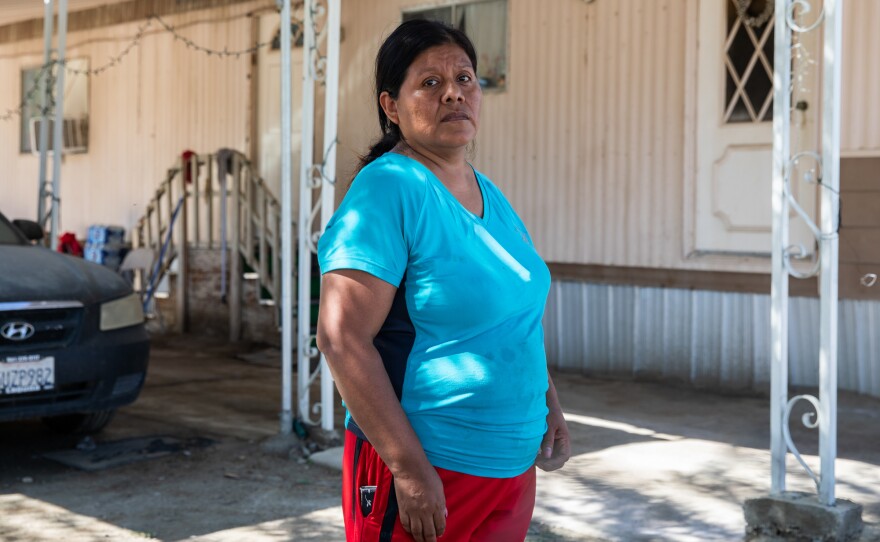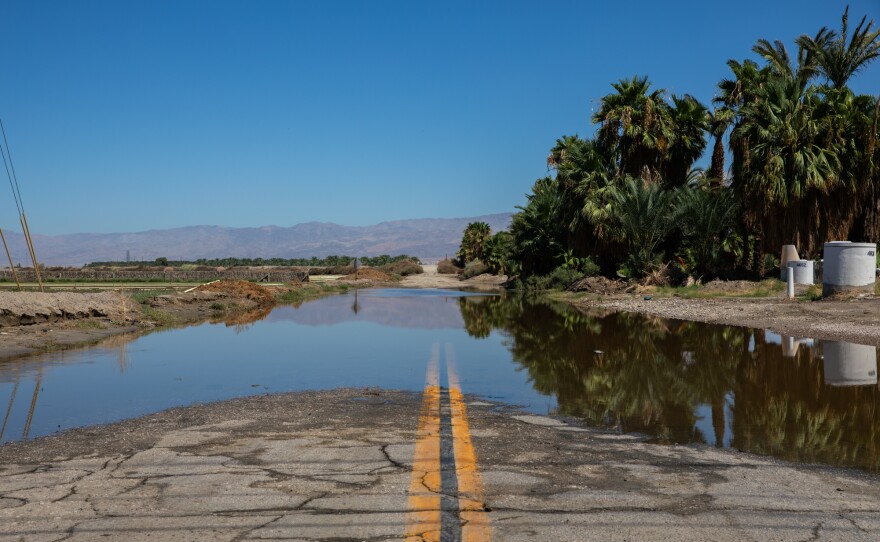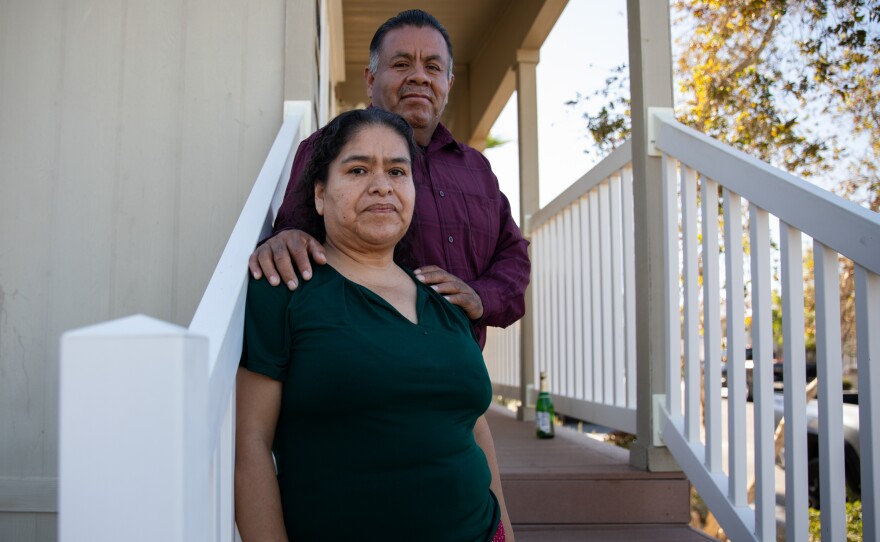Before dawn on a recent morning, as the mud coating Coachella Valley farm fields began to crisp, Entrika Zacarias made her first attempt to drive back to work at a Thermal peach field after four days of no work.
With some roads still blocked, muddy or flooded, driving was risky after Tropical Storm Hilary dumped nearly a year’s worth of rain on the desert town two weekends ago.
Like other immigrant farm workers living there, Zacarias had lost hundreds of dollars because of the storm and couldn’t afford to miss any more days of work. She had rent to pay on the mobile home where she lived with two daughters.
After a couple of days in the peach fields the work ran out. Now she’s looking elsewhere for a job. But her options are slim after the storm left some fields muddy and wet, and others damaged.
“We’re thinking about where to work next and I’m realizing there’s not a lot of work,” she said. “I never stop working all year. I only stop in times like these.”
While Tropical Storm Hilary caused little damage to Southern California’s beaches and cities, rural desert regions like the Coachella Valley were deluged with months of rain over a single weekend. The storm caused an estimated $126 million in damages in Riverside County alone, county officials said Thursday, with most damage in the Coachella Valley.
Low-income immigrant communities across the region bore the brunt of the flooding.
Like Zacarias, many farmworkers in Coachella Valley lack legal status as citizens and therefore don’t qualify for most federal and state disaster aid. Even a new $95 million storm assistance program for immigrants that Gov. Gavin Newsom recently touted is out of reach because it pertains to the winter and spring storms and floods.
“There’s a lack of financial assistance,” said Yunuen Ibarra, program manager with Líderes Campesinas, a network of women farmworker leaders. “What do farmworkers do when they lose their job or a day of their job or a week and they’re not eligible to receive specific financial assistance? There’s not really any specific organization or fund from which farmworkers can get hazard pay or unemployment.”
Center of the storm

A few days before Hilary arrived, Zacarias said, strong winds knocked her power out. It was so hot, she and her daughter took refuge in their car, running its air conditioner for hours. They waited for the brunt of the storm.
Recounting the experience, Zacarias sat in her dark living room under a framed image of the Virgin Mary. The air conditioner hummed and windows and doors were shut to keep sunlight out.
When the worst of Hilary arrived that Sunday, strong winds shook the trailers of the Oasis mobile home community. Zacarias could hear branches smacking her roof and water seeped through a closed window. She put a blanket on her couch to sop it up.
Her two sisters, Martina and Maria Teresa Zacarias, had a similar experience in their homes in another section of the mobile home park.
Part of a porch roof blew off Maria Teresa’s home. Her 10-year-old son cried inconsolably, she said. He had never experienced wind like that.
Martina said she could feel wind blowing between her and the neighboring mobile home while inside her house.
“It was lifting the porch,” Martina said. “The wind was going in between the trailers and I felt that they were separating. The light went out.”
About 6 p.m., Maria Teresa and Martina decided to evacuate to the Galilee Center shelter, a nonprofit that helps families in need, in nearby Mecca. The sisters worried about Entrika, who lives on a dead-end road that became difficult to access once the storm rolled through.
“If something happens to her what would she do alone?” Martina wondered.
A nonprofit called TODEC (for the Training Occupational Development Educating Communities Legal Center), called emergency officials for help. Emergency crews took Entrika to the shelter at about 8 p.m.
“They gave us food, water, clothes, sandals, everything,” Entrika said.
The next day, the day the sisters returned to their homes, the mobile home community’s management sent a message notifying residents there would be no water service due to damages from the storm.


It was another blow for a community already struggling with water issues. For years, the Oasis mobile home community’s water has been contaminated with high levels of arsenic. The state allocated $30 million in the 2021-2022 budget to help Riverside County relocate Oasis residents, but many have struggled to find another place they can afford.
Assemblymember Eduardo Garcia, a Coachella Democrat, said many of the working class, rural communities on the bookends of his district seemed to be most affected, based on reports to his office.
“It’s those folks who live in those areas where the basic infrastructure is lacking,” Garcia said. “And when you have a storm of this magnitude, there’s just no way that the communities are going to be able to withstand that type of situation.”
Tallying the damage
Because undocumented people are legally barred from accessing most types of federal money, including Federal Emergency Management Agency (FEMA) aid programs, in June Newsom’s administration launched the Storm Assistance for Immigrants program. It allows many undocumented residents who live in counties that qualified for FEMA aid to receive state funds to help them recuperate from damaged homes or lost work.
The state fund will distribute about $80 million of its $95 million budget to undocumented residents who can’t get FEMA help for damaged homes or lost work. But it is only for the winter storms and spring floods, state officials said.
So far about $18 million of the $80 million available has gone to about 12,000 undocumented residents, according to Aug. 6 state data. Residents have until May 2024 — or when the money runs out — to apply for the funds.
Advocates have asked Newsom to expand the program to include undocumented residents who lost property or work due to Tropical Storm Hilary.
Riverside County officials also said they will seek assistance from the state, which could then help the county receive federal assistance.
County officials estimated more than $16 million in private property damage, although estimates could change. The rest of the damage includes roads, bridges, water control and debris removal.

Although Newsom declared a state of emergency for California before Hilary hit, the state hasn’t requested assistance from FEMA yet, according to FEMA spokesperson Robert Barker. State emergency management officials began assessing damage in Riverside and San Bernardino counties on Tuesday, said spokesperson Brian Ferguson, and officials won’t know if the damage qualifies for federal assistance for at least another week.
Riverside, Imperial and San Bernardino counties and several cities in the region all declared states of emergency for Hilary, a necessary precursor for securing financial assistance and other aid from either the state or the federal government.
It’s still unclear whether the damages in the Coachella Valley will qualify the region for similar levels of federal assistance that other parts of the state received earlier this year.


When months of storms and torrential rain caused floods and other damage across the state earlier this year, the Biden administration declared major disasters in the state twice, allowing affected residents in qualifying counties to apply for things like emergency Cal-Fresh, unemployment assistance and direct financial payments for damaged homes.
Not all California counties applied for or qualified for that level of individual assistance. But dozens of counties received money to repair damage to public infrastructure like roads and bridges.
Nonprofits are helping the state distribute disaster aid to undocumented residents affected by the winter storms. But the state’s Storm Assistance for Immigrants program leaves out some residents who weren’t living or working in the qualifying counties.
Limits to aid
Martina thought she might be able to get help after the earlier storms when she saw TODEC advertise on social media about payments of $1,500 to $4,500 from the state’s storm assistance for immigrants. But her county, Riverside county, didn’t qualify for the aid.
Although the winter storms didn’t affect the Coachella Valley as much as other parts of Southern California, they made some fields too icy to work in, Martina said.
“Nobody asked us if we needed help,” she said.
During Hilary, Martina missed three days of work in date palm fields. She estimates she lost at least $330. That’s a chunk of her rent or a trip to the grocery store for the month, she said.
“California, unfortunately, is a disaster-prone state. Now, more than ever, we need to come up with a plan like this.”— Assemblymember Freddie Rodriguez, D-Pomona
Entrika said she did not know that the state was offering undocumented immigrants in San Bernardino County thousands of dollars in financial aid for the winter storms.
If that kind of relief were available to her, she said, she wouldn’t have to worry about paying rent, which is bundled with her electricity costs and goes up during the summer. It would have covered the nearly $480 she estimates she lost during four days of missed work, she said.
“It would help me pay my rent and buy clothes for my daughter to start school,” she said.
The little cash aid undocumented communities in Thermal did receive has come from local organizations, like TODEC or Líderes Campesinas. TODEC has distributed nearly $19,000 in grocery cards, protective gear and cash assistance to families in need.

Luz Gallegos, TODEC’s executive director, said Newsom made a surprise, no-press visit to Riverside County the Saturday before the storm hit.
As Hilary approached and clouds thickened, Newsom spoke to organizers and farm workers about their concerns and helped hand out protective gear and grocery store gift cards.
Gallegos said workers told the governor they worried they may lose days of work if the storm flooded the fields and roads.
Gallegos said she asked Newsom to extend the Storm Assistance for Immigrants program to those who would suffer damages from Hilary.
“I showed him the flier and said ‘Governor, we are still helping families affected by the previous storms. Considering what impact this may have, this is something worthwhile to extend for this storm.’ He was there more to listen and to observe,” she said.
A different California storm
But the state is not expanding its storm assistance to residents like the Zacarias sisters and others living and working in towns like Thermal.
Scott Murray, spokesperson for the state’s social services department, which manages the winter storm assistance program said California has made “many recent, significant investments to support our undocumented community.” He pointed to other ways the state is helping, through extending Medi-Cal to more immigrants, offering legal services and publishing disaster assistance guides for immigrants.
Even if California does expand its aid to more immigrants, some undocumented residents say they’re afraid to seek it. They fear that giving information to apply for government programs would make them more vulnerable to immigration enforcement.
Felipe Aguilar and his wife, Domitila Clemente, who live in the Mountain View Estates mobile home community in Thermal, said financial help like the state’s Storm Assistance for Immigrants would be useful now, but they’re apprehensive.
“We’re scared to ask for help. What will happen to us if we ask for help?” Clemente said.
During the storm, Aguilar was on his way to pick up Clemente from nearby Coachella when strong winds knocked down several electricity poles. One grazed the side of his pickup truck, sparking and catching fire.
“I never stop working all year. I only stop in times like these.”— Entrika Zacarias, farmworker from Thermal, Calif., after tropical storm Hilary
Aguilar, a farmworker without legal status, said he had already lost thousands from being out of work for a month due to heat-related health problems. Now, repairing his truck might cost him another couple thousand dollars.
The couple has looked to food banks and asked friends for loans to make it through the month.
Assemblymember Freddie Rodriguez, a Pomona Democrat, said a bill he co-authored could help address these gaps in emergency assistance and speed up the process for residents and local governments to receive disaster funds.
“California, unfortunately, is a disaster-prone state,” Rodriguez said. “Now, more than ever, we need to come up with a plan like this. I think we should have had something like this years ago, but we’ve really got to move something like this forward.”
The bill, the California Individual Assistance Act, would authorize the state emergency management department to create and maintain a grant program to quickly dispense aid to California residents who may not qualify for individual assistance from FEMA, based on that agency’s qualification criteria.
The state’s emergency management department estimated the fiscal impact of the bill would top $1 billion and require at least seven additional staff.
Rodriguez, who chairs the California Assembly’s Committee on Emergency Management, disagreed with their assessment. He said the state could start with the funds already allocated to California’s Disaster Assistance Fund to help local government agencies, and add more money when needed.
The Senate Appropriations Committee scheduled the bill for a suspense file hearing in August. Lawmakers will vote on hundreds of suspense file bills in rapid-fire hearings, starting on the Friday before Labor Day.






